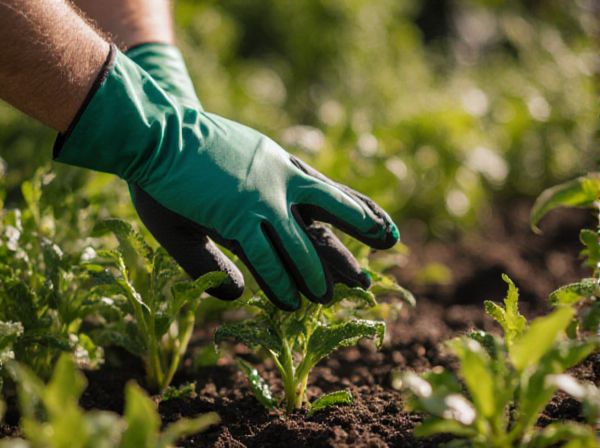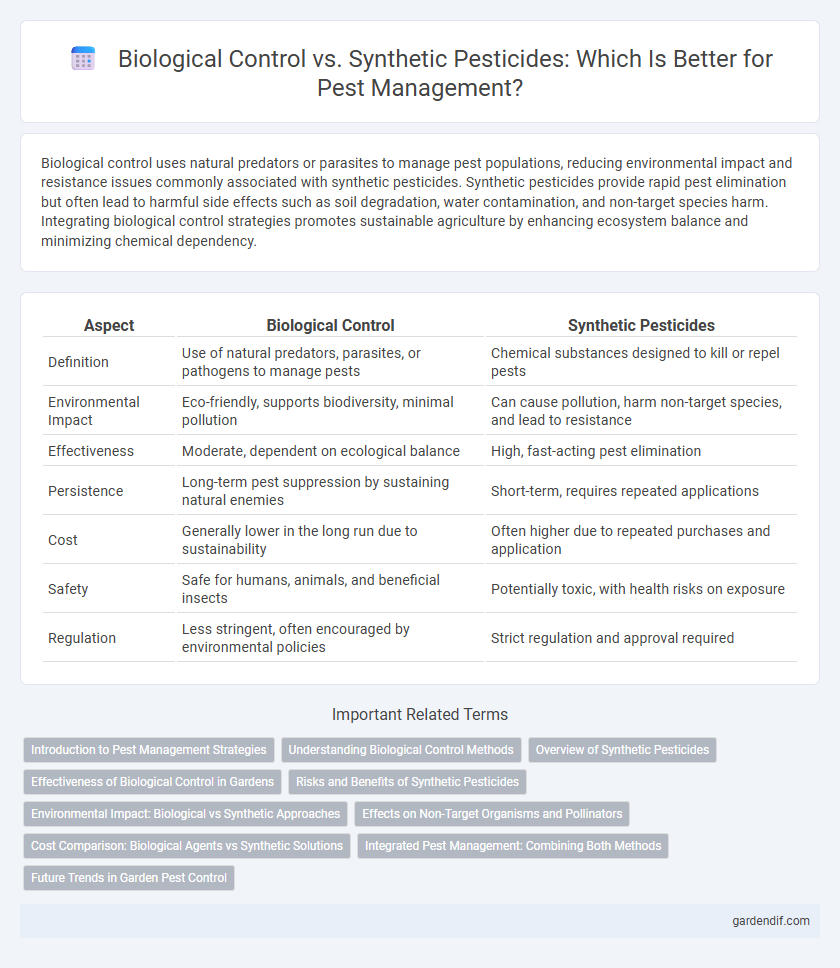
Biological control vs synthetic pesticides Illustration
Biological control uses natural predators or parasites to manage pest populations, reducing environmental impact and resistance issues commonly associated with synthetic pesticides. Synthetic pesticides provide rapid pest elimination but often lead to harmful side effects such as soil degradation, water contamination, and non-target species harm. Integrating biological control strategies promotes sustainable agriculture by enhancing ecosystem balance and minimizing chemical dependency.
Table of Comparison
| Aspect | Biological Control | Synthetic Pesticides |
|---|---|---|
| Definition | Use of natural predators, parasites, or pathogens to manage pests | Chemical substances designed to kill or repel pests |
| Environmental Impact | Eco-friendly, supports biodiversity, minimal pollution | Can cause pollution, harm non-target species, and lead to resistance |
| Effectiveness | Moderate, dependent on ecological balance | High, fast-acting pest elimination |
| Persistence | Long-term pest suppression by sustaining natural enemies | Short-term, requires repeated applications |
| Cost | Generally lower in the long run due to sustainability | Often higher due to repeated purchases and application |
| Safety | Safe for humans, animals, and beneficial insects | Potentially toxic, with health risks on exposure |
| Regulation | Less stringent, often encouraged by environmental policies | Strict regulation and approval required |
Introduction to Pest Management Strategies
Biological control utilizes natural predators, parasites, or pathogens to manage pest populations, offering a sustainable and environmentally friendly alternative to synthetic pesticides. Synthetic pesticides provide rapid and broad-spectrum pest suppression but often carry risks of resistance development, environmental contamination, and non-target organism harm. Integrating biological control with selective synthetic pesticide use forms the foundation of integrated pest management (IPM), optimizing efficacy while minimizing ecological impact.
Understanding Biological Control Methods
Biological control methods utilize natural predators, parasitoids, and pathogens to manage pest populations, offering an eco-friendly alternative to synthetic pesticides. These techniques enhance ecosystem balance by targeting specific pests without harming beneficial insects or causing chemical residues in soil and water. Understanding the lifecycle and behavior of natural enemies is crucial for optimizing biological control effectiveness in sustainable pest management programs.
Overview of Synthetic Pesticides
Synthetic pesticides are chemical compounds formulated to target specific pests, offering rapid and broad-spectrum pest control in agricultural and urban environments. These substances include insecticides, herbicides, and fungicides, designed to disrupt physiological processes in pests, resulting in effective population suppression. Despite their efficiency, synthetic pesticides raise concerns due to potential environmental contamination, pest resistance development, and negative impacts on non-target organisms.
Effectiveness of Biological Control in Gardens
Biological control in gardens harnesses natural predators, parasites, or pathogens to target pest populations, significantly reducing damage without harmful chemical residues. Studies show that using beneficial insects like ladybugs, parasitic wasps, and nematodes can effectively manage aphids, whiteflies, and soil-dwelling pests, promoting sustainable pest control. Unlike synthetic pesticides, biological control minimizes environmental impact and supports biodiversity, leading to long-term pest suppression and healthier garden ecosystems.
Risks and Benefits of Synthetic Pesticides
Synthetic pesticides offer rapid and effective pest control, contributing to increased agricultural yields and reduced crop losses. However, their use poses significant risks, including environmental contamination, harm to non-target organisms such as pollinators and beneficial insects, and the development of pesticide-resistant pest populations. Health concerns arise from pesticide residues in food and water, making integrated pest management and careful application essential to balance benefits and minimize adverse effects.
Environmental Impact: Biological vs Synthetic Approaches
Biological control methods utilize natural predators or parasites to manage pest populations, significantly reducing chemical residues and pollution in soil and water compared to synthetic pesticides. Synthetic pesticides often lead to harmful environmental effects such as biodiversity loss, pesticide resistance, and contamination of ecosystems. The sustainability and eco-friendliness of biological approaches make them preferable for long-term pest management and environmental preservation.
Effects on Non-Target Organisms and Pollinators
Biological control methods such as introducing natural predators or parasites minimize risks to non-target organisms and pollinators by targeting specific pest species with fewer ecological disruptions. In contrast, synthetic pesticides can cause significant harm to beneficial insects like bees and butterflies, leading to pollinator decline and biodiversity loss. Studies indicate that biological control maintains ecosystem balance and supports pollinator health, essential for crop pollination and long-term agricultural sustainability.
Cost Comparison: Biological Agents vs Synthetic Solutions
Biological control methods often have a higher initial investment due to the cost of sourcing and cultivating natural predators or pathogens, but they tend to reduce long-term expenses by minimizing resistance development and environmental damage. Synthetic pesticides generally offer lower upfront costs and rapid pest suppression but can lead to increased expenses over time from resistance management, health risks, and environmental remediation. Cost comparison studies indicate that integrating biological agents can yield sustainable economic benefits by decreasing reliance on repeated chemical applications and associated indirect costs.
Integrated Pest Management: Combining Both Methods
Integrated Pest Management (IPM) strategically combines biological control agents, such as predatory insects and microbial pesticides, with selective synthetic pesticides to minimize pest resistance and environmental impact. This approach enhances pest suppression by leveraging natural enemies and applying chemical treatments only when necessary, reducing overall pesticide use. IPM supports sustainable agriculture by balancing efficacy, economic feasibility, and ecological health.
Future Trends in Garden Pest Control
Biological control methods using natural predators and parasitoids are gaining momentum as sustainable alternatives to synthetic pesticides in garden pest control. Advances in microbial biopesticides and genetically modified organisms are enhancing the specificity and effectiveness against harmful pests while minimizing environmental impact. Integrated Pest Management (IPM) strategies that combine biological agents with reduced-risk synthetic pesticides are expected to dominate future trends, promoting eco-friendly and resilient garden ecosystems.
Biological control vs synthetic pesticides Infographic

 gardendif.com
gardendif.com